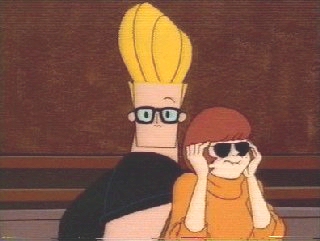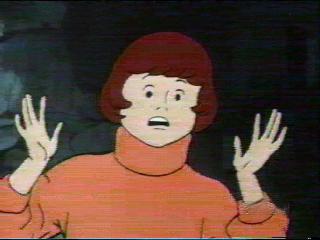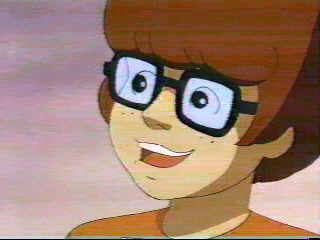| |
A Girl and her Glasses
|
It seems that almost half the people who write me do so to ask about my glasses. The other half probably couldn't care less! Those people can feel free to click on their "back" button because this page
is for all those people who ask the question:
"Why do you need glasses, and how do glasses work?"
|
 |
 |
Lets face it, some people know me as the short girl with the glasses! But, before they were invented, I would have been known as the short blind girl. So, the concept that I can put something on my face
and see, is pretty cool to me! You may wonder why some people need glasses and some people don't. I'm going to try to explain this without getting too technical, and talking about "refraction ratios"
and "diopter numbers", and I am going to just talk about the most common problem, my own, nearsightedness. |
Everyone's face is different. Some people have a round face, some people have an oblong face. The same is true with your eyes. The problem is, only one kind of eyeball works correctly, round! Like a
ping pong ball. Light enters your eye, and is focused on the back of it by a little lens that is located inside your eye. Most people with normal vision can see from about one foot away to 1000 feet away.
People who are nearsighted have eyeballs that are oblong, kind of shaped a bit like an egg. The back of the eye is too far away for the lens to focus correctly on it. We can see things that are real close
because our range of vision is from about one inch to two feet. That's why they call it "Near" sighted. To fix this, we add a lens to the front of the eye... Glasses!
 If you ever look at a pair of glasses that is worn by someone who is nearsighted, the lenses make everything look small. This "tricks" the eye, by making objects seem small and close up, which we can
see just fine. These funny lenses are called "concave" because the center of the lens is thinner than the outside, just the opposite of a magnifying glass. Because the center can only get so thin, the
outside of the lens can get quite thick if you are very nearsighted, thus the "coke bottle" comments! Originally, the lenses in glasses were made of glass, thus the name. Glass works really good at
bending the light, in fact, a lot better than the plastic lenses used now. Also, glass is very scratch resistant (which is why I stuck with it). But, glass has two problems. One, it's heavy! This makes for a
sore nose, believe me! Two, it's glass! Which means, if you happen to drop your glasses on a hard surface, Ka-Bush! There go the lenses! Most newer glasses use plastic lenses. For a few years, this
was not too cool because the lenses had to be twice as thick to bend the light. Talk about your coke bottles! However, they now have high-refraction plastic lenses that work almost as well as glass. If you ever look at a pair of glasses that is worn by someone who is nearsighted, the lenses make everything look small. This "tricks" the eye, by making objects seem small and close up, which we can
see just fine. These funny lenses are called "concave" because the center of the lens is thinner than the outside, just the opposite of a magnifying glass. Because the center can only get so thin, the
outside of the lens can get quite thick if you are very nearsighted, thus the "coke bottle" comments! Originally, the lenses in glasses were made of glass, thus the name. Glass works really good at
bending the light, in fact, a lot better than the plastic lenses used now. Also, glass is very scratch resistant (which is why I stuck with it). But, glass has two problems. One, it's heavy! This makes for a
sore nose, believe me! Two, it's glass! Which means, if you happen to drop your glasses on a hard surface, Ka-Bush! There go the lenses! Most newer glasses use plastic lenses. For a few years, this
was not too cool because the lenses had to be twice as thick to bend the light. Talk about your coke bottles! However, they now have high-refraction plastic lenses that work almost as well as glass.
Nowadays, a lot of people wear contact lenses. That's fine if you don't mind sticking something in your eye. (Personally, I do, thus the glasses!) They work the same way, but the lenses can be small
because they go right on the eye. The lenses are made out of a soft, jelly-like plastic, which kind of reminds me of little jellyfish! People who are really into their looks prefer contacts to glasses.
 |
Well, I hope I haven't bored you. I also hope I have answered some of your questions about why some of us wear glasses...
Best wishes,
Velma Dinkley
Back to The Hub
|
 |
|


 If you ever look at a pair of glasses that is worn by someone who is nearsighted, the lenses make everything look small. This "tricks" the eye, by making objects seem small and close up, which we can
see just fine. These funny lenses are called "concave" because the center of the lens is thinner than the outside, just the opposite of a magnifying glass. Because the center can only get so thin, the
outside of the lens can get quite thick if you are very nearsighted, thus the "coke bottle" comments! Originally, the lenses in glasses were made of glass, thus the name. Glass works really good at
bending the light, in fact, a lot better than the plastic lenses used now. Also, glass is very scratch resistant (which is why I stuck with it). But, glass has two problems. One, it's heavy! This makes for a
sore nose, believe me! Two, it's glass! Which means, if you happen to drop your glasses on a hard surface, Ka-Bush! There go the lenses! Most newer glasses use plastic lenses. For a few years, this
was not too cool because the lenses had to be twice as thick to bend the light. Talk about your coke bottles! However, they now have high-refraction plastic lenses that work almost as well as glass.
If you ever look at a pair of glasses that is worn by someone who is nearsighted, the lenses make everything look small. This "tricks" the eye, by making objects seem small and close up, which we can
see just fine. These funny lenses are called "concave" because the center of the lens is thinner than the outside, just the opposite of a magnifying glass. Because the center can only get so thin, the
outside of the lens can get quite thick if you are very nearsighted, thus the "coke bottle" comments! Originally, the lenses in glasses were made of glass, thus the name. Glass works really good at
bending the light, in fact, a lot better than the plastic lenses used now. Also, glass is very scratch resistant (which is why I stuck with it). But, glass has two problems. One, it's heavy! This makes for a
sore nose, believe me! Two, it's glass! Which means, if you happen to drop your glasses on a hard surface, Ka-Bush! There go the lenses! Most newer glasses use plastic lenses. For a few years, this
was not too cool because the lenses had to be twice as thick to bend the light. Talk about your coke bottles! However, they now have high-refraction plastic lenses that work almost as well as glass. 
